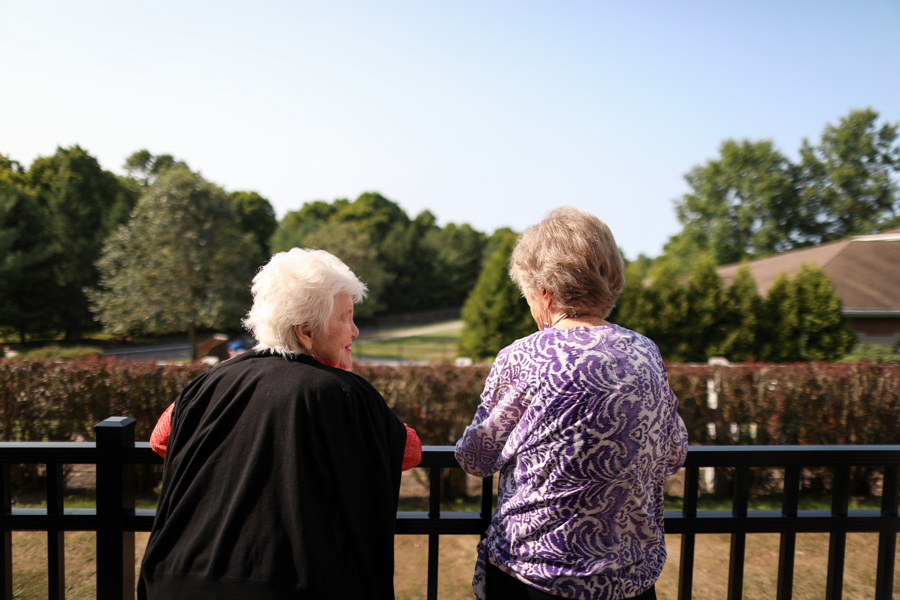Independent Living vs Assisted Living

For many families, the search for senior living begins with questions. An adult child may wonder what level of support a parent needs, while a couple might look ahead and ask how they can simplify daily life while staying active and connected. With so many options available, it’s natural to feel uncertain about which path to take.
A new resident moving into either Independent Living or Assisted Living would quickly find their social circle expanding, surrounded by peers ready to become friends. They would also enjoy a variety of activities that support physical and cognitive wellness, along with a wide range of amenities designed to enrich daily life.
At Meadow Ridge, both lifestyles are available within one community—surrounded by the beauty of Redding, CT—so residents can embrace the lifestyle that feels right today, with confidence that support is available should their needs change.
As you read on, you will gain a better understanding of the differences and similarities between Independent Living and Assisted Living, helping you or a loved one feel confident in the decision and the lifestyle that’s right for you.
Levels of Care
Choosing the right senior living option often comes down to the level of support you or a family member may need. Senior living exists on a continuum—Independent Living provides the most freedom while Assisted Living adds extra support for daily routines. Both offer opportunities to stay active, connected and engaged.
Independent Living: Maintenance-Free Ease
Independent Living is ideal for older adults who can live independently but want to enjoy a lifestyle that’s maintenance-free and engaging. Think of it as trading in the responsibilities of homeownership—like gutter cleaning, lawn care or unexpected repairs—for a life where those details are handled for you and you can focus on what brings you joy.
Independent Living typically offers:
- Housekeeping
- Full-service dining
- Social activities and events
- Wellness programs
- Landscaping
- Transportation
- Security services
Assisted Living: Support with Independence
Assisted Living is for seniors who are active but need some support with daily routines such as bathing, dressing or managing medications. It offers a balance of independence and care in a comfortable, home-like setting. Staff are available around the clock, including at least one medical professional in most communities.
Assisted Living typically includes:
- Assistance with daily living – providing help with bathing, dressing, eating and other personal needs
- Wellness programs
- Social activities and events
- Medication management
- Housekeeping
- Transportation
Both Independent and Assisted Living are about living life fully—whether that means letting go of household chores or receiving a little extra support along the way.
Living Spaces
Independent Living
Independent Living residents live in a private residence and enjoy access to inviting common areas where they can socialize with neighbors. Since these spaces are designed for seniors who still live independently, the features and amenities in each residence are comparable to those in a small home, townhouse or apartment. They can include fireplaces, balconies, dining areas and washer/dryers. At Meadow Ridge, apartment homes are spacious, customizable and thoughtfully designed to feel like home, with multiple floor plans to fit every lifestyle.
Assisted Living
Assisted Living residents usually enjoy a home that is an apartment-style, sometimes with kitchenettes, and includes easy access to services at the community. Meadow Ridge offers a variety of Assisted Living floor plans, including Deluxe Two-Bedroom, Two-Bathroom apartment homes.
Amenities
Independent Living
Independent Living amenities are designed to make residents’ daily lives vibrant and maintenance-free, with services designed to minimize day-to-day responsibilities. This lifestyle allows seniors to focus on the activities and experiences that bring them joy and connection, all while living in a safe, welcoming environment.
Amenities at Meadow Ridge include the Bark Ridge dog park, the Ridge Range golf simulator, 24/7 fitness center, pickleball and tennis courts and an indoor heated saltwater pool.
Assisted Living
Assisted Living offers a similar emphasis on independence, while providing additional support as needed. Residents often participate in exercise classes, support groups and field trips, all within a vibrant and social community. Transportation services help residents get to appointments, run errands, or enjoy outings, without the stress of driving or maintaining a personal vehicle.
At Meadow Ridge, Assisted Living residents have access to all Independent Living amenities, as well as those exclusive to Assisted Living residents including a new library and business center, activities room and an outdoor patio with fireplace.
Financial Options
When choosing between Independent Living and Assisted Living, understanding your financial options is an important part of the decision-making process. Every senior’s situation is unique, and the right choice depends on personal circumstances and resources.
Independent Living
Independent Living is ideal for seniors who can live independently and want a lifestyle free from household responsibilities. Payment is typically private and may come from:
- Home sale
- Retirement savings
- Pension income
- Social Security benefits
- Life settlements
- Annuities or other personal funds
Assisted Living
Assisted Living provides additional support for seniors who need help with daily activities. Payment options may include all of the options listed above, as well as:
-
Certain long-term care insurance policies
-
Aid and Attendance benefits from the U.S. Department of Veterans Affairs
Note: Medicare does not cover Assisted Living.
The Right Fit for You
Seniors today have more care options than ever. For many, continuing care retirement communities (CCRCs) offer an ideal fit.
At a CCRC like Meadow Ridge, our Lifecare program guarantees access to Assisted Living, Memory Care, Sub-Acute Rehabilitation or Skilled Nursing. Residents can enjoy Independent Living with the confidence that additional support is available should they ever need it.